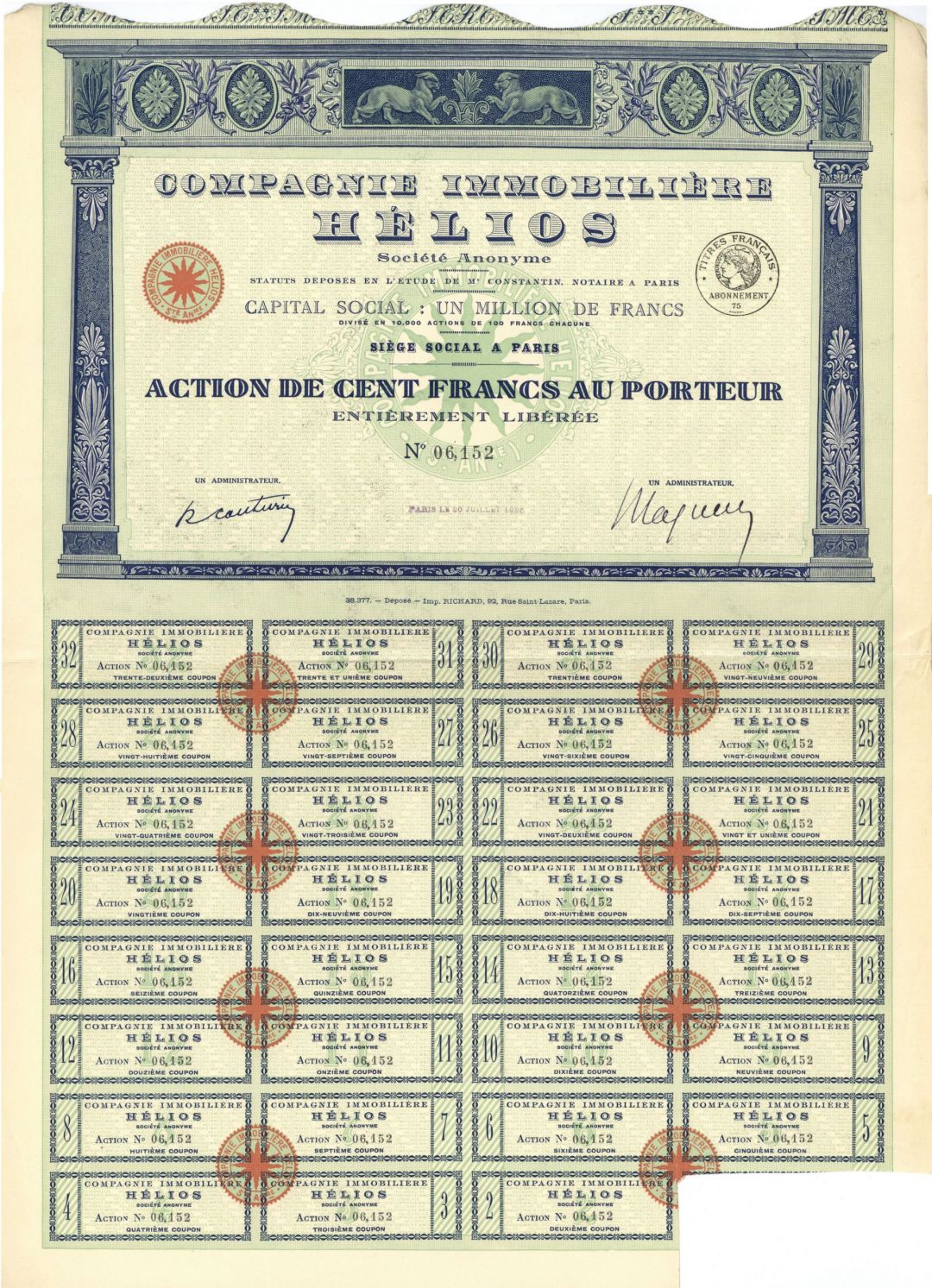Compagnie Immobiliere Helios - Stock Certificate
Inv# FS1776 StockStock. All coupons but 1 remain.
In ancient Greek religion and mythology, Helios is the god and personification of the Sun (Solar deity). His name is also Latinized as Helius, and he is often given the epithets Hyperion ("the one above") and Phaethon ("the shining"). Helios is often depicted in art with a radiant crown and driving a horse-drawn chariot through the sky. He was a guardian of oaths and also the god of sight. Though Helios was a relatively minor deity in Classical Greece, his worship grew more prominent in late antiquity thanks to his identification with several major solar divinities of the Roman period, particularly Apollo and Sol. The Roman Emperor Julian made Helios the central divinity of his short-lived revival of traditional Roman religious practices in the 4th century AD.
Helios figures prominently in several works of Greek mythology, poetry, and literature, in which he is often described as the son of the Titans Hyperion and Theia and brother of the goddesses Selene (the Moon) and Eos (the Dawn). Helios' most notable role in Greek mythology is the story of his mortal son Phaethon who asked his father for a favour; Helios agreed, but then Phaethon asked for the privilege to drive his four-horse fiery chariot across the skies for a single day. Although Helios warned his son again and again against this choice, explaining to him the dangers of such a journey that no other god but him was capable to bring about, Phaethon was hard to deter, and thus Helios was forced to hand him the reins. As expected, the ride was disastrous and Zeus struck the youth with one of his lightning bolts to stop him from burning or freezing the earth beyond salvation. Other than this myth, Helios occasionally appears in myths of other characters, witnessing oaths or interacting with other gods and mortals.
In the Homeric epics, his most notable role is the one he plays in the Odyssey, where Odysseus' men despite his warnings impiously kill and eat his sacred cattle the god kept at Thrinacia, his sacred island. Once informed of their misdeed, Helios in wrath asks Zeus to punish those who wronged him, and Zeus agreeing strikes their ship with a thunderbolt, killing everyone, except for Odysseus himself, the only one who had not harmed the god's cattle, and was allowed to live. After that, Helios troubles Odysseus no more in his journey.
Due to his position as the sun, he was believed to be an all-seeing witness, and thus was often invoked in oaths. He also played a significant part in ancient magic and spells. In art he is usually depicted as a beardless youth in a chiton holding a whip and driving his quadriga, accompanied by various other celestial gods such as Selene, Eos, or the stars. In ancient times he was worshipped in several places of ancient Greece, though his major cult centers were the island of Rhodes, of which he was patron god, Corinth and the greater Corinthia region. The Colossus of Rhodes, a gigantic statue of the god, adorned the port of Rhodes until it was destroyed in an earthquake, thereupon it was not built again.
A stock certificate is issued by businesses, usually companies. A stock is part of the permanent finance of a business. Normally, they are never repaid, and the investor can recover his/her money only by selling to another investor. Most stocks, or also called shares, earn dividends, at the business's discretion, depending on how well it has traded. A stockholder or shareholder is a part-owner of the business that issued the stock certificates.











Ebay ID: labarre_galleries